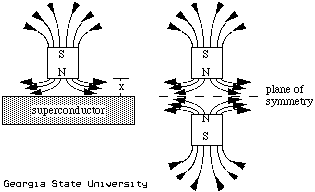Superfluids
Superconductors
A Type 1 superconductor in a magnetic field will completely repel all field lines. This is called the Meissner effect, and it is an example of perfect diamagnetism. The perfect exclusion of a magnetic field can be explained by using Faraday's law. Recall that the integral over a closed loop of E dotted with ds is equal to the rate of change of the magnetic flux. Since no potential difference can exist in a superconductor (there is no resistance to make one possible), then the magnetic field inside a superconductor cannot change.
If B inside a superconductor cannot change, what if there was a magnetic field present when the superconductor was cooled past its Tc point? Physicists predicted that the magnetic field would remain in the superconductor, even once the external field was turned off. However, when the experiment was carried out, the magnetic field was expelled from the conductor as soon as Tc was reached. This proved that not only can the magnetic field not change, but it must be zero inside a superconductor. Surface currents in a superconductor act to exactly counter any applied magnetic field, and this is how one can levitate a magnet above a superconductor.
 |
 |
|
A magnet being levitated above a superconductor of |
A diagram of the field lines of the manet being repelled by the superconductor. |
A funny picture of a sumo wrestler on a magnet levitated above a high-temperature superconductor (taken from www-hfml.sci.kun.nl/ hfml/levitate.html - University of Nijmegen).
